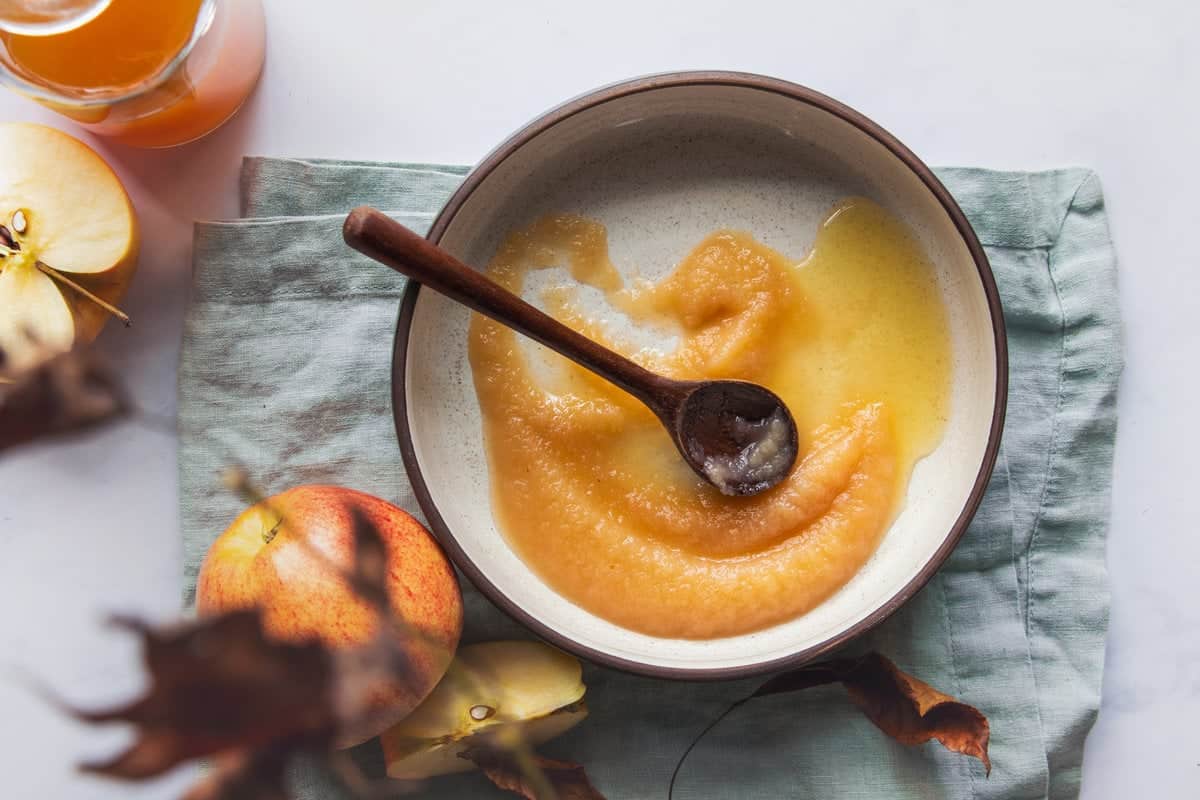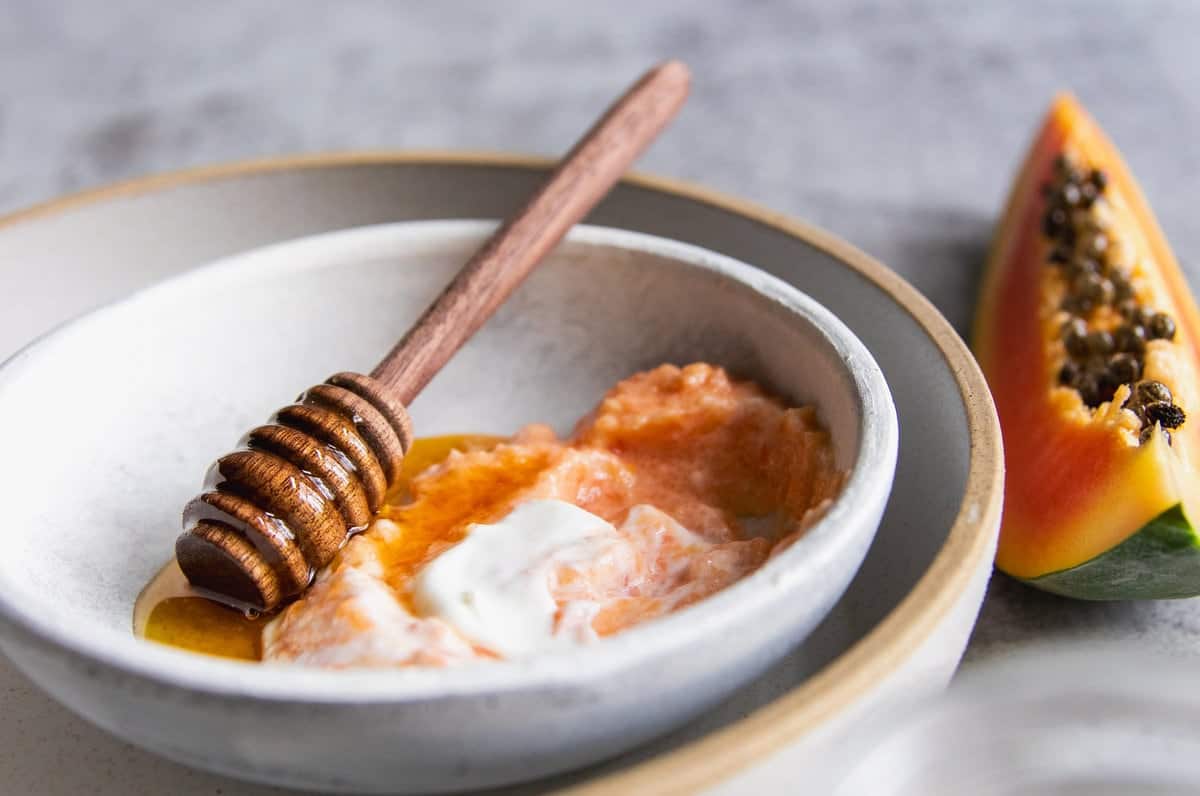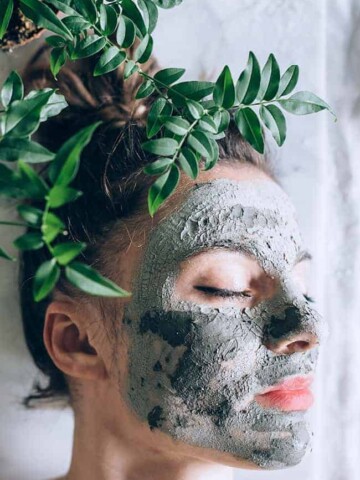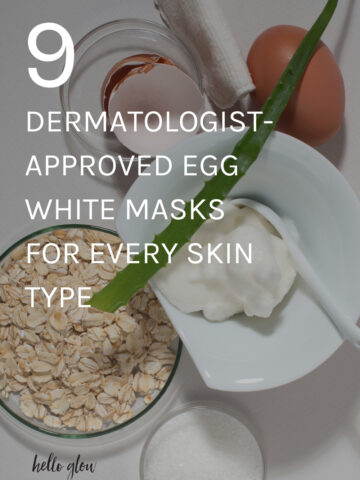Rather than reaching for a peel-in-a-bottle, we've got seven natural skin peels you can make in minutes. And DIY face peels pretty much do it all: tackle flakes, cleanse pores, make wrinkles less noticeable. What's not to love?
And did we mention they're gentle, even on sensitive skin? Perfect for a skin a pick-me-up!

Ever wonder which “peel” would work the best for your skin? There are many types of homemade chemical peels to choose from depending on your skin type and the results desired. Each peel targets a specific problem or issue.
Let’s break them down so the next time you’re scouring the shelf in search of a cleanser or exfoliant or scheduling a treatment with your esthetician, you understand the options and potential benefits of each choice.
Jump to:
- Benefits of At Home Face Peels
- Types of Face Natural Face Peels
- How To Make an At-Home Face Peel
- How to Use a Natural Skin Peel
- 1. Apple Cider Vinegar Peel for Normal Skin
- 2. Clear Pores with a Salicylic Face Peel
- 3. Fade Sun Damage with Citric Acid Face Peel
- 4. Turn Back the Clock with Tartaric Acid Face Peel
- 5. Fade Age Spots with Malic Acid Face Peel
- 6. Brighten Complexion with Enzymatic Face Peel
- 7. Gently Exfoliate with Lactic Acid Face Peel
- Low Acid DIY Peels
- FAQ
Benefits of At Home Face Peels
Exfoliation: Chemical peels work by removing the top layer of dead skin cells, promoting exfoliation. A homemade face peel for dead skin can lead to smoother, brighter skin and a more even skin tone.
Improved Texture: Regular use of at-home peels can contribute to improved skin texture, reducing the appearance of fine lines, wrinkles, and rough patches.
Reduced Hyperpigmentation: Peels can help fade dark spots and hyperpigmentation caused by sun damage, acne, or other skin conditions. They promote cell turnover, revealing fresh, evenly pigmented skin.
Acne Treatment: Chemical peels can be beneficial for individuals with acne-prone skin. They help unclog pores, reduce excess oil production, and improve the overall condition of the skin.
Stimulated Collagen Production: Some peels stimulate the production of collagen, a protein that provides structure to the skin. This can contribute to firmer and more elastic skin.
Minimized Pore Size: Regular exfoliation through chemical peels can help reduce the appearance of enlarged pores by preventing them from becoming clogged with debris.
Enhanced Product Absorption: By removing the top layer of dead skin cells, peels can enhance the absorption of other skincare products, allowing them to penetrate more deeply into the skin.
Convenience and Cost-Effectiveness: At-home peels offer the convenience of being able to make them at home and apply them as often as you like. They can also be more cost-effective compared to professional treatments.
Types of Face Natural Face Peels
There are generally just two types of acids used in face peels:
AHA Peels: Alpha hydroxy acids (AHAs) are water soluble rapid chemical exfoliators derived from different fruits and plants found in nature, helping with cell turnover and the shedding of dead skin cells. AHAs, including glycolic acid and lactic acid, are water-soluble acids that primarily exfoliate the surface layer of the skin. AHAs are found in grapes, citrus fruits, apples, pineapples, and papaya.
BHA Peels: Beta hydroxy acids (BHAs) are also natural exfoliants, however, unlike AHAs, they are oil soluble, penetrating deeper into pores to breakdown excess oily sebum. BHAs are found in foods such as almonds, cherries, tomatoes and berries.
How To Make an At-Home Face Peel
It turns out that there are many mild, homemade facial peels you can make at home with ingredients you already have on hand.

Fruit acids: Choose fruits that contain natural acids, such as citric acid (lemons, oranges), malic acid (apples), or tartaric acid (grapes).
Yogurt or buttermilk: Contain lactic acid and has a soothing effect.
Papaya or pineapple: Contain enzymes like papain and bromelain, which aid in exfoliation.
Aspirin: Aspirin contains salicylic acid, a beta-hydroxy acid which acts as a chemical peel to reduce acne and lesions.
Apple cider vinegar: When it comes to DIY skin peels, apple cider vinegar is a star—thanks to its high acid content. Acetic acid is the one we hear about most often, but ACV is also chock full of lactic, citric, and malic acids as well.
Pick a combination of ingredients based on the acids they contain. For example, a combination of citric, malic, and lactic acids can offer a well-rounded exfoliation.
How to Use a Natural Skin Peel
Just like store-bought peels, homemade peels can do serious damage if not used properly. Never leave a peel on overnight or for an extended period. And if you notice an abnormal amount of stinging, redness, or irritation, wash it off immediately and use a bit of baking soda mixed with water to cool the burn.
For best results:
- Use your at-home skin peel in the evening once a week.
- Before applying the peel to your entire face, perform a patch test on a small area to ensure you don't have an adverse reaction.
- Apply a thin layer to clean, damp skin and leave on for 5-10 minutes. Rinse with cool water.
- Follow up with lotion or a gentle serum to lock in moisture.
- Throw away any extra and make a fresh batch each time.
- Always wear sunscreen in the 2–3 days post-peel.
Important Notes:
- If you have sensitive skin or any skin conditions, consult with a dermatologist before attempting a DIY peel.
- Discontinue use if you experience redness, irritation, or any adverse reactions.
- Perform the peel no more than once a week to avoid over-exfoliation.
1. Apple Cider Vinegar Peel for Normal Skin

I recommend doing this apple cider vinegar chemical peel at night or before a shower as the pungent vinegar scent tends to linger! This mask doesn't keep well, so it's best to make only enough for one application.
Ingredients
- 1 teaspoon organic, raw, unfiltered apple cider vinegar
- 1 tablespoon applesauce, preferably organic or homemade
Instructions
Remove all makeup and wash your face. Mix the ingredients to form the mask mixture. Then apply the mask to your face and neck with clean fingers, but avoid the eye area (that would seriously sting!).
This apple cider vinegar face mask can be a little runny, so lie down for 10–15 minutes to avoid it dripping everywhere.
Remove the mask with a soft cloth and cool water and follow with moisturizer. And don't forget to wear sunscreen the next time you head outside.
2. Clear Pores with a Salicylic Face Peel

Salicylic acid is derived from the same Willow Bark Tree as aspirin and is known for its anti-inflammatory properties. Typically chosen to treat acne and/or sun damage, salicylic acid is extremely effective at curbing breakouts and clogged pores.
Ingredients
- 1-2 uncoated aspirin tablets
- 1-2 teaspoon water or aloe vera gel
- 1 teaspoon honey (optional for additional moisturization)
Instructions
- Place uncoated aspirin tablets in a small bowl or mortar. Crush the tablets into a fine powder using the back of a spoon or a pestle.
- Add 1-2 teaspoons of water or aloe vera gel to the crushed aspirin. You can adjust the amount based on the desired consistency. If you want additional moisturization, you can add 1 teaspoon of honey to the mixture. Honey also has antibacterial properties.
- Leave on for about 5-10 minutes. Monitor your skin closely for any signs of discomfort.
- Rinse with cool water and apply a moisturizer.
Note: Anyone allergic to aspirin should avoid using salicylic acid. Also, aspirin can be irritating to some individuals, so it's crucial to perform a patch test before applying this at-home skin peel to your entire face.
3. Fade Sun Damage with Citric Acid Face Peel

Citric acid is primarily used to dry out excess sebum and clean out dead skin cells within pores. However, citrus fruits are not the only fruits that contain citric acid. Try berries, kiwis, sour cherries, or tomatoes.
Ingredients
- 1 tablespoon fresh orange juice
- 1 tablespoon yogurt (for added lactic acid and moisture)
- 1 teaspoon honey (moisturizing and antibacterial)
Instructions
- Mix the fresh citrus juice with yogurt and honey to create a smooth paste.
- Apply the mixture to your face, avoiding the eye area.
- Leave on for 5-10 minutes.
- Rinse off with lukewarm water and follow with a moisturizer.
4. Turn Back the Clock with Tartaric Acid Face Peel

Tartaric acid falls into the category of polyhydroxy acids, offering a milder form of exfoliation and contributing to the overall health and appearance of the skin.
Ingredients
- 2 tablespoon mashed grapes or grape juice
- 1 tablespoon plain yogurt (contains lactic acid)
Instructions
- Mash grapes (or use grape juice) and mix with yogurt.
- Apply the mixture to your face, avoiding the eye area.
- Leave on for 10-15 minutes.
- Rinse off with lukewarm water and follow with a moisturizer.
5. Fade Age Spots with Malic Acid Face Peel

Often naturally derived from apples, malic acid is used to smooth the skin and treat short-term hyperpigmentation. This at-home skin peel is considered minimally irritating, so it's safe for sensitive skin.
Ingredients
- 2-3 tablespoon mashed apple
- 1 tablespoon honey (moisturizing)
- 1 teaspoon almond oil (nourishing)
Instructions
- Mash a ripe apple and mix it with honey and almond oil.
- Apply the mixture to your face, avoiding the eye area.
- Leave on for 10-15 minutes.
- Rinse off with cool water and follow with a moisturizer.
6. Brighten Complexion with Enzymatic Face Peel

Pineapple and papaya contain natural fruit enzymes that act as exfoliating agents. Proteolytic enzymes like bromelain and papain break down proteins to help remove dead skin cells and promote a smoother complexion.
Ingredients
- 2-3 tablespoon mashed ripe papaya or pineapple
- 1 tablespoon yogurt (for added lactic acid and moisture)
- 1 teaspoon honey (moisturizing)
Instructions
- Mash ripe papaya or pineapple and mix with yogurt and honey.
- Apply the mixture to your face, avoiding the eye area.
- Leave on for 10-15 minutes.
- Rinse off with cool water and follow with a moisturizer.
7. Gently Exfoliate with Lactic Acid Face Peel

A milder choice among DIY chemical peels, lactic acid is derived through the fermentation process, typically from sour milk. Lactic acid is a fantastic choice for more sensitive skin types, and is great for treating pore size, uneven complexion, and pigmentation.
Using buttermilk in a DIY skin peel can help promote gentle exfoliation, improve skin texture, and provide a mild brightening effect, but you can also substitute milk or plain, full-fat yogurt.
Ingredients
- 1-2 tablespoon buttermilk (enough to cover your face)
- 1 teaspoon aloe vera gel (optional for soothing effects)
- 1 teaspoon baking soda
Instructions
- Pour 1-2 tablespoons of buttermilk into a bowl. If you have sensitive skin, you may want to start with a smaller amount and gradually increase it over time. For additional exfoliation, you can add 1 teaspoon of baking soda. If you want to enhance the soothing effects, add 1 teaspoon of aloe vera gel.
- Leave the mixture on your face for a short duration, such as 10-15 minutes. Monitor your skin closely for any signs of discomfort.
- Rinse off with lukewarm water and follow with a moisturizer.
Low Acid DIY Peels
A facial peel with a lower acid content, such as one made with pumpkin, cucumber, or green tea, is perfect for sensitive skin. Use any of the following DIY skin peels to brighten a sensitive complexion.
FAQ
Occasionally they can be combined, depending on manufacturer instructions and strengths. Since glycolic acid will continue to penetrate the skin until it is neutralized while salicylic acid is self-neutralizing, they will rarely be found together. I do not recommend mixing them without proper professional training for the products used.
Unless the two acids are combined in the same product, I recommend using them on alternate days, or different times of day. For instance a glycolic acid cleanser may be used in the morning and a salicylic acid cleanser used in the evening.
If you notice stinging, persistent redness, or peeling, back off on the frequency of peels or products with AHAs in them, and be sure to be hydrating appropriately after use. Skin needs often change with seasons, travel, and hormonal changes so be aware of these changes.
Yes, you can apply a skin peel to your body. Just like with an acid facial peel, make sure to do a patch test first and always apply to freshly cleansed skin. Rinse off immediately if you notice excess burning or redness.
This post was medically reviewed by Dr. Rina Mary Allawh, M.D., a dermatologist who practices adult and pediatric medical dermatology, skin cancer treatment, and cosmetic dermatology. Learn more about Hello Glow's medical reviewers here. As always, this is not personal medical advice, and we recommend that you talk with your doctor.
309



